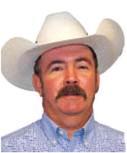It does not seem time for another growing season, but here we are at the beginning of one.
For most people, the new year starts January 1, but for farmers it starts when growing season starts.
As I write this article, corn is going in the ground. It is earlier than usual, but the weather looks to be right for an early planting this year.
Other crops will be later, but not far behind the corn crop and with these warmer temperatures it will not be long before bermudagrass starts greening-up.
What does this growing season hold in store for us?
Well in the end only God knows, but we can use what science that is available to make some predictions and/or best guesses.
We know that right now we have the best soil moisture going into spring that we have had in a couple of years.
We also know that according to the National Weather Service (NWS) we have an average chance of rain with most likely average temperatures through May.
After May, the predictions are more bleak as we move back into the dreaded La Nina pattern.
This pattern brings us a 40% chance of higherthan- average temperatures and a 40% chance of less than average rainfall. The good news is that currently the prediction is to move back into normal or average rainfall about August, but to stay hotter than normal.
This is a similar pattern from the last two years, where we received at least some rainfall in the spring and then the spigot cut off until we got a good September or October rain.
Last year’s late summer/ fall rainfall was a real blessing and made a huge difference for many livestock producers, most of which had already started feeding hay. It helped our fields recover before winter and gave most of us some muchneeded grazing going into winter and even allowed for a final hay cutting for some. Some experts say we will be in this La Nina type weather pattern for the next 2 to 3 years. While I this is not the case, it is best to be prepared either way.
How can you prepare for such conditions? Corn farmers are opting to plant early this year to take advantage of early moisture. Livestock producers and grass farmers should be sure soil nutrients are where they need to be early on this year. You do not want to apply nitrogen on bermudagrass yet, but now is the time to get your phosphorus (P) and potassium (K) in order. Many fields suffered from last year’s drought, these fields will need the correct amount of P+K for the roots to recover and the grass to re-spread and produce well. While fertilizer is not cheap, prices are lower than they have been for the last two years.
With the nice current conditions, you also must be careful not to get too optimistic about your stocking rates.
I know most everyone destocked heavily the last two years, but now may not be the best time to attempt to restock. Replacements are very high and as you can see the weather predictions are not the best. It is always best to be understocked and have the potential to grow a little extra grass than to be overstocked and have to purchase additional highpriced hay and supplements.
As I mentioned above, in the end we really do not know what the weather is going to do, but it is always better to plan for a worstcase scenario and have some options, than it is to get pushed into a corner with nothing but expensive, bad options. Have your soil ready to take advantage of any early moisture; with proper soil nutrients they will get through the dry spells better and respond much quicker when we do get rainfall.

